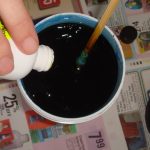Once the developed image is obtained, a large amount of unexposed and undeveloped silver halide remains in the emulsion. If that silver halide is not removed before the image is exposed to radiation capable of producing a latent image, the image will continue to darken. The process of removing the residual silver halide from the image is called “fixing.”
The silver halides are only slightly soluble in water; therefore, to remove the material remaining after development it is necessary to convert it to soluble complexes which can he removed by washing. Sodium thiosulfate, commonly termed “hypo,” has been used for this purpose since 1839.
The reactions in fixing can be written as follows:
AgBr + S2O3-2 –> AgS2O3– + Br– (adsorption complex)
which is followed by
AgS2O3– + S2O3-2–> Ag(S203)2–3 (desorbed)
and by
Ag(S203)2-3 <–> AgS2O3– + S2O3 -2; AgS2O3 <–> Ag+ + S2O3-2
Within limits, the rate of fixation is indicated by the clearing time, i.e., the time required to remove all visible traces of silver halide from the image. This time depends on the concentration of thiosulfate, the temperature, the agitation of the solution, but more particularly on the emulsion and the extent to which the fixing bath has been used. Fine-grain emulsions fix in less time than those of larger grains, and paper emulsions of silver chloride fix faster than bromo-iodide negative emulsions. Thickly coated films, other things being equal, fix more slowly than those with a thin emulsion coating. The fixing time increases appreciably as the solution becomes depleted. With continued use the halide-ion concentration rises in proportion to the amount of silver halide dissolved. When the product of the silver-ion and the halide-ion activities reaches the solubility product of the least soluble silver halide present, the solution will dissolve no more of that silver halide and fixation will necessarily be incomplete
It is usually desirable to harden the gelatin after development, and while this may be accomplished by a hardening stop bath prior to fixing, the usual practice is to combine hardening with fixing. The conventional fixing and hardening bath contains in addition to the fixing agent:
1. An organic acid, usually acetic, to provide the necessary acidity to stop development and create the proper pH for effective hardening.
2. Sodium sulfite, which prevents the decomposition of the thiosulfate by the acid and forms colorless oxidation products of the developer thus preventing staining.
3. Alum as a hardening agent.
The hardening produced by alum is due to the reaction of the aluminum ions, Al+3, and the carboxyl groups of the gelatin with the formation of cross-linkages between chain molecules. The degree of hardening, other things such as temperature, alkalinity of the film when placed in the fixing bath, etc., being equal, depends on the pH of the solution which in turn depends on the relative proportions of acid, sulfite and alum.
Since the addition of developer tends to increase the pH of the fixing bath, the solution should be buffered against an increase in pH. For this reason weak organic acids, such as acetic acid, are used in preference to a stronger acid, such as sulfuric. The addition of boric acid increases the useful hardening life of potassium alum baths and reduces the tendency of the bath to form a sludge.



Comments are closed